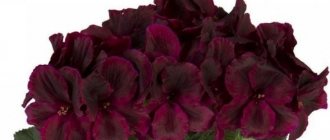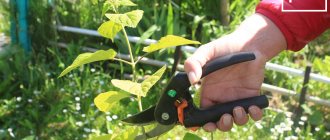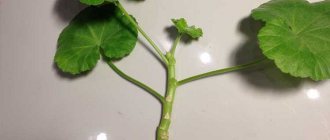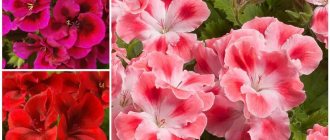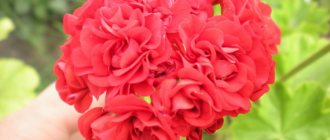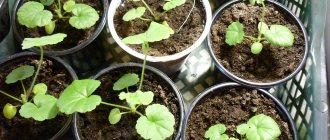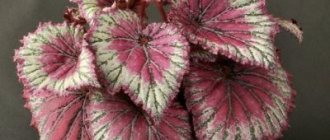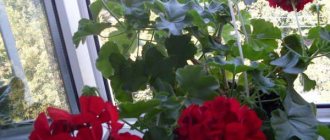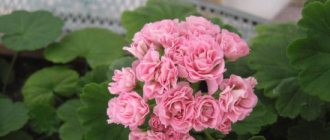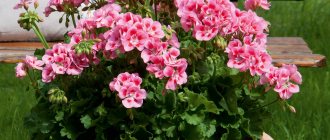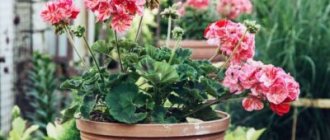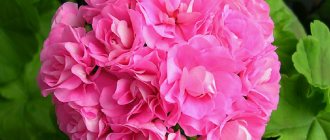Propagation of royal geranium by cuttings
Queen, queen, queen of Pelargosh - this is how flower growers lovingly call the royal large-flowered geranium. Created by German breeders, it attracts attention and makes you fall in love with it:
- emerald green pubescent leaves;
- huge, from 15 cm in diameter, inflorescences that do not rise from above, like other pelargoniums, but cover the entire bush with a cloud;
- generous flowering from March to October;
- the diversity and uniqueness of varieties, color shades and flower shapes.
You can propagate a queen growing at home all year round. Pruning broken or thickening shoots, thinning and pinching during flowering, preparing adult geraniums for winter rest, shortening the tops in February - all operations provide material suitable for stem cuttings.
Brief description of the flower
Royal geranium (or pelargonium) is a large-flowered perennial species with flowers 5-15 cm in diameter. They are similar in shape to pansies. Colors can be varied. During flowering, the plant resembles a bright ball. It reaches a height of 60 cm.
Did you know? The names of both geraniums and pelargoniums come from the ancient Greek language. The first is translated as “crane”, the second as “stork”. The flower received these names due to the similarity of the fruits to the beaks of these birds.
Growing conditions for royal geranium
Typically, garden and indoor geraniums are clear contenders for the title of the most unpretentious and undemanding indoor plant. But their royal relatives love attention and care. If a gardener is tormented by the question: “Why doesn’t the royal geranium bloom next to the lush caps of bright zonal varieties?”, it is not the plant that needs to be blamed, but itself. Obviously, the culture is not entirely satisfied:
- lighting;
- selected watering mode;
- room temperature;
- the presence of a draft;
- how pruning is carried out;
- soil quality or pot size.
To care for royal geraniums at home, it is important to create conditions in which the plant would be comfortable throughout the year. This type of pelargonium:
- does not tolerate drying out of the earthen clod;
- does not do well in excessively wet dense substrate;
- it quickly stretches out and loses its decorative appearance without the proper amount of light, but it is also uncomfortable under the staring direct rays.
Without additional shading on the south window, geranium leaves and flowers are at risk of burns and rapid wilting. The optimal location for royal geranium is east or west. But even here in winter, it is better to illuminate the plants with phytolamps, extending their daylight hours to 12–14 hours. This measure will allow you to maintain the compact shape of the bush without deep pruning.
Properly chosen temperature conditions contribute to good health and lush flowering of geraniums:
- In the summer months and spring, when the growing season is active, royal geranium flowers are kept at a temperature of 22 to 25 °C.
- In winter, development slows down somewhat, so plants need cooler air. In order for the royal geranium to set buds and prepare for the next season, it needs a temperature of 12–16 °C.
Plants react poorly to heat. In a too warm room, a green pet will slow down its growth, and some varieties stop developing altogether and refuse to form flower buds.
Nuances of aftercare
Royal geranium requires special treatment. In order not to wonder in the future why my geranium does not bloom, it is better to provide all the necessary conditions for pelargonium from the very beginning :
- Temperature and humidity. Normal room temperature, without sudden changes and drafts, is most favorable for our aristocrat. Humidity should be moderate, but dry air near radiators will have a bad effect on its condition.
- Lighting. Geranium loves the sun very much, but it is better to keep cuttings and seedlings in moderately sanctified places. Once your plants are strong enough, you can take them outside in warm, windless weather. Such sunbathing will help flowers and leaves show their colors most clearly. It is not recommended to plant the queen pelargonium in open ground for the summer; it is too delicate for such conditions.
- Watering. We have already talked about this, watering should be sufficient.
It is best from below, through the pallet. This way you will not flood the plant, and the lower roots will receive the required amount of water. The water must be warm, otherwise the roots may rot. - Feeding. It is recommended to feed geranium from the end of the dormant period, every 2 weeks until the end of flowering, with complex mineral fertilizer for flowering plants.
- Bush formation. When 3-4 leaves appear on a young plant, its top is pinched. This results in a more lush and squat bush. You can also pinch the following shoots, but remember that each such manipulation delays the start of flowering.
- Removing buds. All wilted flowers should be removed immediately. This will save more energy for the formation of new flowers.
- Autumn pruning. When the flowering of the geranium is over and the dormant period is approaching, the plant is pruned. The shoots growing from the leaf axils are removed, and the main ones are shortened. 6-7 leaves remain on each shoot.
You can read more about caring for geraniums here.
How to properly obtain cuttings from large-flowered geraniums?
Material for cuttings of royal pelargonium is obtained with the arrival of spring and until mid-summer. Cuttings are harvested either during the formation of the bush or during the first pruning. In the first case, it is allowed to leave shoots for propagation throughout the year, and in the second - only from spring and the first half of summer.
Cut the cuttings slightly below the level of the internodes. The cut is made at an angle of 45 degrees. Take a sharp tool. To prevent infection of the plant, it is recommended to pre-treat the blade. Shoots should not be broken off. This will damage the pelargonium. The length of the cutting depends on the variety of geranium. If the mother plant belongs to a dwarf variety, shoots approximately five centimeters long are separated. Ten-centimeter ones are taken from large specimens. All existing flowers and leaves are completely torn off from the cuttings. Some types of royal pelargonium, grown for several years, have quite long shoots. To collect planting material from such plants, the cuttings are simply cut to the required size, that is, each is cut into pieces of 5-10 centimeters.
Cuttings of geraniums according to the lunar calendar. Step-by-step cuttings of pelargonium
1. First you need to take a well-sharpened knife, disinfect it with alcohol and very carefully cut the stalk, its length should be at least 5 centimeters. The cut should be made at an angle of 90 degrees to the stem, however, some gardeners advise cutting geraniums at an angle of 45 degrees so that there is a larger area for the roots to appear.
The cutting must have at least two or three leaves, otherwise the cutting may not gain a foothold in the ground, and may ultimately die in new extreme conditions for it. It is necessary to remove every flower arrow and bud from the cuttings. Housewives want to see young pelargonium blooming as soon as possible, but the right time for this has not yet come. If you leave the buds on the cutting, it will begin to waste energy on blooming flowers, and it will not have enough energy to take root. Practice shows that 90 percent of flowering geranium cuttings die after some time when planted.
2. Cut pelargonium cuttings should be placed in a shaded place for about two hours so that the cuts dry well and are covered with a film. After this time, the sections must be covered with crushed activated carbon or the drug “Kornevin”.
3. Planting cuttings of pelargonium. Prepared cuttings are most often planted in plastic cups. At the bottom of these cups, you need to use a knife to make several holes for drainage, through which excess water will drain and the soil will be ventilated.
Next, you need to pour soil into the cups. You can take universal soil and mix it with vermiculite and sand. It is necessary to moisten this soil thoroughly. To kill all harmful microbes and organisms in the substrate, you can pour boiling water or a weak solution of potassium permanganate onto it. You need to wait for the soil to cool, then stick the cutting into it about 2-3 centimeters deep. There should be no leaves on the part of the stem that goes into the ground, and if there are any on the cutting, they need to be removed.
There is no need to cover the planted geranium cuttings with anything. However, if the leaves begin to turn yellow, the plants can be covered with a transparent plastic cup or glass jar. After a couple of days, the leaves should turn green again, after which the container can be removed.
A newly planted cutting does not need to be watered frequently, since it does not yet have roots, so it does not need abundant moisture. But the soil must not be allowed to dry out, because if the soil dries out, the cutting will also dry out. You need to water little by little, so that water does not get on the leaves and stem.
4. Within a few weeks, roots will begin to appear on the cutting. How to determine that they have appeared? If the cutting was planted in a transparent plastic glass, the young roots will be clearly visible there. In addition, the appearance of roots will be noticeable by other signs: new leaves will appear on the cuttings, which will gradually increase in size, this is a good signal that the young plant has taken root and is developing well.
Possible growing difficulties
Errors in caring for royal pelargonium can affect the condition of the plant and its flowering. Various diseases and pest damage cannot be avoided.
Find out how to properly use iodine to fertilize geraniums.
The most dangerous among them:
- Rot. Affects the root system. The disease manifests itself as yellowing of the leaves, and then their blackening and lethargy of the entire plant. It is treated by establishing proper care, regularly loosening the soil, removing diseased leaves and sections of rhizome, and treating with fungicides.
- Rust. A disease caused by a fungus. The pathogen provokes the appearance of light spots on the upper leaf plate and rusty spots on the lower one. The diseased plant is cleaned of damaged leaves. The frequency of watering is reduced to the maximum, but the volume of water is increased. Spraying with “Fitosporin”, “Fundazol”, “Topaz”, and Bordeaux mixture is used.
- Bacteriosis. The symptoms are as follows: with normal watering, the leaves turn yellow and dry out, and the stem becomes covered with black rot at the base. You will have to part with a sick plant; it will not be possible to cure it. Flowers that were nearby should be treated with one of the fungicides - “Fitosporin”, “Alirin-B”, “Gamair”, “Abiga-Pik”.
- Root and stem rot. Often develops due to improper soil selection. Treatment with Fitosporin M, Alirin-B, Fitolavin, replanting with simultaneous treatment of the soil with Glyokladin is necessary.
- Thrips. The fact that these parasites have taken a fancy to the plant is indicated by small holes on the leaves, brown spots, and deformation of the stems. Their reproduction is facilitated by dry air and lack of spraying. They are treated by spraying with insecticides “Aktellik”, “Inta-Vir”, “Fitoverm”, “Aktara”.
- Ticks. A characteristic symptom that these pests have settled on a flower is the presence of small yellow dots on the leaves. Favorable conditions for their spread are heat and dryness. You can get rid of parasites by wiping with a soap solution, using Fitoverm, Bi-58, Karate, Iskra-M, and Aktellik products.
- Aphid. This is a sucking parasite that feeds on the juices of the plant, as a result of which it withers, its leaves turn yellow, curl and fall off. Wiping the flower organs with soapy water and spraying with insecticides “Akarin”, “Inta-Vir”, “Fufanon”, “Fitoverm”, “Aktara” help fight aphids.
In addition to the ailments and parasites described above, when growing geraniums, other difficulties may arise, which the plant can tell about through changes in appearance:
- The leaves have turned yellow. The cause of this problem is insufficient watering. To eliminate it, it is necessary to remove the yellow leaves and increase the volume and frequency of watering.
- The plant does not produce flowers for a long time. This behavior of the flower indicates that it does not have enough light, it is too cold, there are not enough or too many minerals in the soil, it has an overly large pot, and it has not been pruned for a long time. To correct the situation, it is necessary to find the true cause and eliminate it.
- The leaves dry out. If the tips of the leaves dry out, this is a sign that the flower does not have enough water. It is necessary to increase the fluid intake. If flowers, buds, or whole leaves dry out, this may indicate the presence of a fungal infection. In this case, spraying with fungicides (for example, Fitosporin) will help.
- Brown growths appeared on the lower leaf plate. The reason is strong root moisture and high humidity. It is necessary to control the humidity level and bring it to normal levels.
Important! It is not uncommon for geranium leaves to turn yellow soon after transplantation. This is normal and temporary. You should tear off the yellowed parts of the plant and follow the recommendations for care and necessary conditions.
Royal geranium is a capricious plant that not everyone can grow. It requires constant attention, special conditions and painstaking care. If you get the hang of it, it will delight you with its gorgeous blooms for a long time. It is better to propagate it by cuttings.
How to propagate a plant?
Best time
The most favorable period for propagation of royal geranium depends on the chosen method . So, it is better to start cuttings in August - September, and plan to plant seeds in the spring.
Let's consider each type of breeding of royal pelargonium separately and in more detail.
Methods
Cuttings
The best way to propagate this type of pelargonium is cuttings. The favorable period for this is August-September. Take the apical cutting of a royal pelargonium plant with 2-3 internodes. Only the bottom leaf on the cutting is cut off, and the rest are saved .
Rooting of cuttings is carried out in the spring, or shoots obtained from pruning in August are planted. It is important that the air temperature is no higher than +25 °C.
How can you root cuttings? There are 2 ways to do this:
- Place the prepared cuttings in a container of water. In order for royal pelargonium to produce more root shoots, experts advise adding a few drops of a root growth stimulator, in the dosage specified by the manufacturer. Caring for shoots that are rooted in water is a little easier.
- Another way to get high-quality planting material:
- Dry the cuttings for 2.5 hours;
- plant in a substrate consisting of peat and sand or special soil for geraniums and pelargoniums.
Do not moisten the soil at the planting stage. The pot with the earth mixture and cuttings does not need to be covered on top with a glass jar or bag. Then a rare watering regime is established. After 3 weeks, when rooting is complete, it is necessary to pinch the central bud of the young plant, this will ensure its branching.
Feeding can begin after another 2 weeks. Then you can transplant the plant to a permanent place.
Below is a visual video about cuttings of Royal Pelargonium:
Dividing the bush
This is the least troublesome method for those who own a large adult royal pelargonium. This method is advisable to use for planned transplantation. Small parts with a sufficient root system are separated from an adult plant and compressed into a separate container .
Seeds
To obtain it from seeds at home, it is necessary to mechanically pollinate the flower. The seeds grow in a capsule, which is a pointed pod. When it is ripe, it bursts.
To collect seed material, the most beautiful and powerful buds are left on the mother plant during the flowering period. It is better to cut off the rest so that the plant does not waste energy.- After the seeds are completely dry, it is necessary to select the largest ones.
- Then you need to leave the collected material in a weak solution of potassium permanganate for 4 hours or damage the thick skin manually, and then sow it into a shallow container filled with a light, damp substrate.
Below is a visual video about planting Royal Pelargonium with seeds:
Propagation by seeds
Propagation by seeds is another way to obtain a large number of plants. It has a significant drawback - the seeds grow into plants that differ in characteristics from the mother plant. The color of the flowers, their shape, and doubleness are lost. If your main goal is to quickly green up your garden, then propagating by seeds is an excellent option. In this case, they use seeds collected from their flowers. To create certain color compositions, seeds are purchased at a flower shop.
Note! Geranium is planted with seeds mainly in cases where a large number of plants are involved at once, for example, to decorate city parks and flower beds. Cuttings are not suitable for such volumes.
Before planting, they prepare their own seeds - they carry out scarification. The shell of pelargonium seeds is very dense and hard, which is why they can lie in the soil for 3 months before they germinate.
Scarification technology involves gently grinding the seeds between two sheets of fine-grained sandpaper. When sowing geranium seeds, the following factors are taken into account:
- the correct time for sowing seeds (you can start planting from the end of December or the beginning of January);
- dependence of temperature conditions and timing of germination (substrate temperature should be maintained within 18-20 ℃ above zero);
- substrate (turf soil, sand and peat in a ratio of 2:1:1);
- proper picking and care of sprouts.
You should not delay picking, otherwise the root system will grow and become intertwined. The development of seedlings will be delayed. After the sixth leaf appears on young plants, they are pinched and shaped so that in the future geranium grown from seeds at home will delight with lush flowering.
Growing pelargonium from seeds
When is the best time to perform the procedure?
The choice of time of year for propagating royal begonia depends on the intended method:
- Cuttings.
The most suitable period for cuttings is from August to September. It is during this period that the plant is pruned after flowering, and the cut shoots can be used as planting material. Dividing the bush.
For propagation of royal pelargonium by dividing the bush, the recommended time is late spring - early summer: it is during this period that the plant is in the active growing season, so it can easily withstand any manipulation.
Sowing of seeds is usually done in March. It is possible earlier, but then the seedlings will need additional lighting with a phytolamp.
